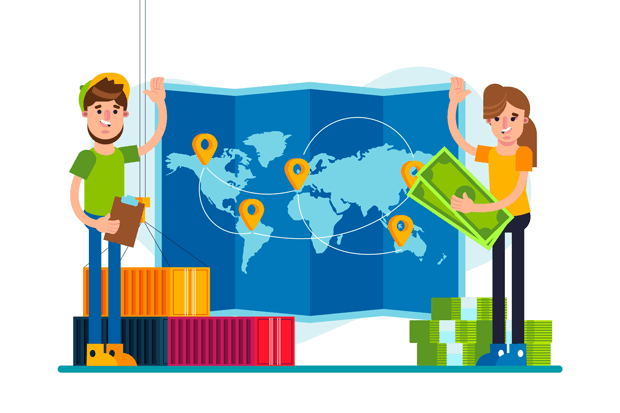In 2023, global e-commerce sales reached an impressive $5.9 trillion, and projections indicate a continued upward trajectory.
A significant portion of this growth is attributed to cross-border e-commerce, highlighting the increasing comfort and desire of consumers to purchase from international sellers.
For merchants utilizing the Shopify platform, which empowers millions of businesses across over 170 countries, the potential for international expansion is substantial.
However, venturing into global markets involves navigating a complex web of logistics, regulations, and cultural nuances.
This guide serves as a comprehensive roadmap for Shopify store owners seeking to successfully sell internationally, providing the foundational knowledge and actionable strategies to thrive in the global marketplace.

Laying the Foundation: Setting Up Your Shopify Store for International Success
Embarking on the journey of international selling requires a well-structured foundation within your Shopify store.
Shopify Markets emerges as the central hub for managing your global operations, offering a suite of tools designed to streamline the complexities of selling across borders .
A. Understanding and Utilizing Shopify Markets
Shopify Markets is an integrated tool that allows merchants to tailor the online shopping experience for different countries and regions.
Within this framework, a market can encompass a single country or a group of countries sharing similar characteristics and strategic approaches.
For instance, a “North America” market could include Canada, the United States, and Mexico, all managed under a unified set of settings. Conversely, a country like Japan, with its unique market dynamics, might warrant its own dedicated market.
Upon the initial setup of a Shopify store, the platform automatically generates a “Primary market,” typically aligned with the store’s address and base currency, representing the default customer experience.
Additionally, an “International market” is curated, suggesting popular countries where businesses similar to yours have found success.
All other countries not included in these initial markets are categorized under “Countries you don’t sell to,” where customers are unable to complete purchases.
This automatic segmentation provides a valuable starting point for merchants considering international expansion.
To begin selling in new territories, merchants can easily add and activate new markets through the Shopify admin.
The process involves navigating to the Markets section, clicking “Add market,” and specifying the desired countries or regions. These markets can be single-country or encompass multiple countries with similar targeting strategies, such as shared product pricing, shipping rates, and domain.
Once a market is added, it needs to be activated to allow customers in those regions to make purchases. Shopify also provides the functionality to set a specific market as the “Primary market,” which defines the store’s core operational base.
Furthermore, merchants can preview how their storefront will appear to customers in different markets, ensuring a localized and relevant experience.
It is important to note that the number of markets a store can have is dependent on the chosen Shopify subscription plan .
| Shopify Plan | Number of Markets |
| Basic | 3 |
| Shopify | 3 |
| Advanced | 9 |
| Plus | Up to 50 |
The management of Shopify Markets also involves considerations around staff permissions.
Accessing and modifying market settings requires specific permissions, including access to Home, Orders, Products, Analytics, Discounts, Catalogs, and Store settings related to shipping, taxes, and domains.
This granular control allows for tailored international strategies, catering to businesses with diverse global ambitions and ensuring the right team members have the necessary access to manage specific markets effectively.
The intuitive market segmentation and the level of control offered by Shopify Markets simplify the initial setup and ongoing management of international sales operations.
B. Mastering International Shipping and Delivery Logistics
Efficient international shipping is a cornerstone of successful global e-commerce. Customers expect reliable and transparent delivery, regardless of their location.
Shopify provides a range of tools to streamline this crucial aspect of international selling .
A fundamental step is setting up specific shipping zones for your target international regions.Within the Shopify admin, merchants can create these zones and then define the shipping rates and methods available for each zone.
This allows for tailored pricing and service options based on the destination country or region. It is crucial to research the capabilities and restrictions of various carriers for your intended markets, as not all carriers ship to every location or handle all types of goods.
Proactive research into carrier options is essential to avoid logistical complications and ensure reliable delivery.
For businesses located in the United States, Canada, or Australia, Shopify offers an integrated shipping solution called Shopify Shipping . This feature allows merchants to purchase international shipping labels directly from their Shopify admin, simplifying the process of creating labels and completing necessary customs forms.
Additionally, for eligible businesses in the US and Canada, the Shopify Fulfillment Network offers another option, where products are stored and shipped to customers on the merchant’s behalf.
Beyond Shopify’s native solutions, a variety of third-party shipping apps are available on the Shopify App Store, offering advanced automation features and integration with a wider range of carriers.
Transparency in shipping details is paramount for international customers. Merchants should clearly communicate shipping prices, estimated delivery times, and any potential customs delays at the checkout.
Robust packaging is also essential for international shipments to withstand longer transit times and potentially more handling . Some merchants may choose to implement a small handling fee for international orders to account for the additional complexities involved.
The integrated shipping solutions offered by Shopify, coupled with the flexibility of third-party apps, simplify the often-complex process of managing international shipping, reducing operational burdens for merchants.
C. Navigating International Payment Gateways and Currency Conversion
Enabling international customers to pay in their preferred methods and currencies is vital for a seamless shopping experience and can significantly impact conversion rates.
Shopify offers various options for handling international payments and currency conversion .
A key step is to enable multiple currencies within your Shopify store, allowing customers to browse and pay in their local currency . Shopify Payments plays a significant role in this, enabling the processing of payments in a customer’s local currency.
However, it’s important to note that Shopify Payments is only available in certain countries.
For regions where Shopify Payments is not available or for merchants seeking more options, integrating with third-party payment gateways is essential.
Popular choices for international transactions include PayPal, Stripe, Adyen, and WorldPay, among a wide array of other available gateways.
Activating local payment methods that are popular in your target markets, such as Alipay or iDEAL, can further enhance the customer experience and boost conversion rates .
Shopify Payments offers automatic currency conversion, simplifying the process for merchants. When a customer selects a local currency, the prices are automatically converted based on current exchange rates. It’s important to be aware that Shopify charges a currency conversion fee for this service.
For merchants who prefer greater control over exchange rates, Shopify allows the setting of manual exchange rates for markets that are not the primary market.
Additionally, various currency converter apps are available on the Shopify App Store, offering enhanced features for displaying and managing currencies.
Offering the ability to transact in local currencies and preferred payment methods significantly enhances the shopping experience for international customers, aligning with the preferences of the majority of online shoppers.
D. Demystifying International Taxes, Duties, and Regulations
Navigating the complexities of international taxes, duties, and regulations is a critical aspect of global selling that requires careful attention to ensure compliance and avoid potential issues.
Merchants need to understand the tax regulations of the countries they are selling to, which may include Value Added Tax (VAT), Goods and Services Tax (GST), or other local taxes.
Additionally, international shipments may be subject to customs duties upon arrival in the destination country.
The Harmonized System (HS) code, a standardized international system of names and numbers to classify traded products, is required for international orders to facilitate customs clearance.
Specifying the country of origin for products is also a necessary step .
Merchants should familiarize themselves with the concepts of Delivered Duty Paid (DDP) and Delivered Duty Unpaid (DDU) shipping options.
DDP means the seller is responsible for all duties and taxes, while DDU (now often referred to as Delivered at Place – DAP) means the buyer is responsible. It is crucial to clearly communicate your policies regarding taxes and duties to your customers, ideally at the checkout process, to avoid unexpected costs and ensure a smooth delivery experience.
Given the intricacies of international tax laws, it is often advisable to consult with tax professionals who specialize in international e-commerce to ensure accurate guidance and compliance.
Paying close attention to international tax and duty regulations and potentially seeking expert advice are essential for avoiding penalties and ensuring a positive customer experience.
Conquering International Search Engines: Optimizing Your Shopify Store for Global SEO
To effectively reach international customers, optimizing your Shopify store for global search engines is paramount. This involves strategic decisions about your website’s domain structure and the implementation of specific SEO techniques .
A. Choosing the Right Domain Structure for Your International Strategy
Selecting the appropriate domain structure is a foundational element of your international SEO strategy. Different structures send varying signals to search engines about your target audience .
Country Code Top-Level Domains (ccTLDs), such as .ca for Canada or .uk for the United Kingdom, provide the strongest indication to search engines that your content is specifically targeted towards users in those countries.
This can lead to improved rankings within those specific regions and enhance user trust as it signals a local presence. However, using multiple ccTLDs can be more expensive and may require a local presence in each target country.
Furthermore, managing SEO efforts across multiple domains can be resource-intensive.
Subdomains, like uk.example.com or france.example.com, offer a degree of localized branding and can be hosted on servers within the target regions, potentially improving website speed.
While they allow for more distinct localized experiences, search engines may treat subdomains as separate entities from the main domain, requiring independent efforts to build domain authority for each subdomain.
Subdirectories, also known as subfolders, such as example.com/uk/ or example.com/fr/, are often favored for international SEO as they consolidate domain authority, making SEO management easier.
Content within subdirectories benefits from the main domain’s existing authority, potentially leading to faster ranking in international search results.
While geo-targeting might be slightly less precise than with ccTLDs, subdirectories are generally recommended, especially for businesses with established domain authority.
Generic Top-Level Domains (gTLDs) with language parameters in the URL (e.g., example.com?lang=en) are generally not recommended for international SEO as they can be confusing for search engines and less user-friendly.
For most Shopify merchants, utilizing subdirectories under a primary gTLD like .com offers a strong balance between SEO benefits, ease of management, and cost-effectiveness.
B. Implementing Hreflang Tags Correctly for Multi-Language and Multi-Region Targeting
Hreflang tags are crucial HTML attributes that tell search engines which language and regional version of a webpage to display to users based on their language preferences and geographic location.
They are essential for websites with multilingual or multi-regional content, preventing duplicate content issues that can negatively impact SEO .
Shopify simplifies the implementation of hreflang tags for stores using international domains and subfolders created through Shopify Markets, as these tags are automatically generated.
This built-in functionality ensures that search engines understand the relationship between different language and regional versions of your store’s pages.
However, for merchants with more complex setups or those who prefer manual control, hreflang tags can also be implemented directly within the <head> section of the theme’s code.
Alternatively, various apps available on the Shopify App Store can assist with managing hreflang tags, particularly beneficial for larger stores or those with intricate international targeting requirements .
When implementing hreflang tags, it is vital to use accurate ISO 639-1 language codes (e.g., “en” for English, “fr” for French) and, optionally, ISO 3166-1 Alpha-2 region codes (e.g., “US” for the United States, “CA” for Canada) to specify the target language and region precisely (e.g., en-US, fr-CA).
Each language or regional version of a page should have a corresponding hreflang tag, including a self-referential tag that points back to the current page .
While Shopify’s automatic implementation is a significant advantage, understanding the principles of hreflang tags allows merchants to verify their correct implementation and address potential issues, maximizing their international SEO performance.
C. The Art of Translation and Localization: Beyond Just Words
While translation involves converting text from one language to another, localization encompasses a broader adaptation of content to suit the cultural nuances, local customs, and expectations of a specific target market.
Effective international selling requires both accurate translation and thoughtful localization .
For crucial content such as product descriptions, marketing materials, and legal information, it is highly recommended to utilize professional human translators who possess both linguistic proficiency and cultural understanding.
Shopify offers its own translation and localization app called Translate & Adapt, which allows merchants to translate their store’s content into multiple languages.
While it offers automatic translation for a limited number of languages, manual editing is often necessary to ensure accuracy and cultural relevance. Numerous third-party translation apps, such as Weglot, Langify, Lokalise, Blend, Transcy, and Localize, are also available on the Shopify App Store, offering a range of features and integrations.
For merchants who prefer a more manual approach, Shopify allows the import and export of translations using CSV files .
Beyond direct translation, localization involves adapting content to resonate with the local audience. This includes conducting local keyword research to ensure your store is optimized for the terms your target customers are actually using.
It also means tailoring your content to reflect local idioms, references, and cultural sensitivities . Even elements like date and time formats, measurements, and currencies should be adapted to the local conventions.
Notably, Shopify allows for the translation of URL slugs, enhancing the localized feel of your store . Finally, ensuring that your website has a clearly visible language switcher allows international shoppers to easily select their preferred language, further improving their experience.
Effective localization builds trust with international customers and significantly improves conversion rates by providing a shopping experience that feels familiar and relevant .
Crafting Your Global E-commerce Strategy: Reaching and Engaging International Customers
Expanding your Shopify store internationally requires a well-defined strategy for identifying target markets and engaging with customers in those regions .
A. Identifying Your Ideal International Markets: Research and Analysis
Data-driven research is paramount when selecting which international markets to enter. Shopify provides valuable analytics within your store admin, particularly the “sessions by location” report, which reveals where your current international website traffic and sales are originating.
This provides a solid starting point for understanding existing international interest in your products. Beyond your own data, market research tools like Ahrefs can help analyze your competitors’ international presence and identify potential opportunities .
A thorough evaluation of market potential involves considering factors such as market saturation, current demand trends for your product type, and any untapped niches.
Analyzing economic indicators and industry reports from government sources and international trade organizations can provide valuable insights into the economic stability and growth potential of different markets.
Conducting online consumer surveys or organizing focus groups in potential target markets can yield direct feedback on consumer preferences and the likelihood of your products resonating with the local audience.
For businesses new to international selling, starting with countries that are geographically close or culturally similar can often provide a smoother entry into the global marketplace.
Careful market research allows merchants to focus their resources on the most promising international opportunities.
B. Understanding Diverse Consumer Behaviors and Cultural Nuances
Success in international markets hinges on understanding that consumer behaviors and cultural preferences vary significantly across different regions.
Failing to account for these differences can hinder your marketing efforts and lead to lower conversion rates .
Payment method preferences are a key area to consider. While credit and debit cards are widely accepted, certain regions may have a strong preference for alternative payment methods such as PayPal, local bank transfers, or mobile payment solutions.
Understanding these local preferences and offering relevant payment options is crucial for a smooth checkout process. Product demand can also vary considerably between markets.
What is a best-selling item in one country might have limited appeal in another.
Conducting market-specific research can help identify which of your products are likely to be most successful in different international markets.
Beyond practical considerations like payment and product demand, cultural nuances play a significant role. Language is an obvious factor, but also consider customs, holidays, local traditions, and overall communication styles.
Tailoring your website’s language, imagery, and even your customer service approach to align with local cultural norms can significantly enhance the customer experience and build buyer trust.
By demonstrating an understanding and respect for local cultures, businesses can foster stronger relationships with international customers.
C. Developing Localized Marketing Campaigns for Global Impact
A successful international e-commerce strategy requires the development of marketing campaigns that are specifically tailored to each target region.
A one-size-fits-all approach is unlikely to yield optimal results in diverse global markets .
Creating region-specific marketing campaigns allows you to tailor your messaging, promotions, and even the platforms you use to reach your target audience.
This includes localizing your ad copy and imagery to resonate with the cultural context and language of each market .
Different social media platforms and online channels have varying levels of popularity in different regions, so it’s important to focus your efforts on the platforms where your target customers are most active.
Search engine optimization (SEO) and content marketing efforts should also be localized, including optimizing for local search engines and creating content that addresses the specific interests and needs of each market.
Email marketing campaigns can be segmented and personalized based on the language and preferences of your international customers . Finally, consider partnering with international influencers who have a strong following within your target markets to promote your products and brand.
Localizing your marketing efforts ensures that your message is relevant and engaging, leading to improved campaign performance and a stronger connection with international customers.
D. Providing World-Class Customer Support for Your International Clientele
Excellent customer support is paramount for building trust and fostering long-term relationships with your international customers. Addressing the unique needs and challenges faced by international shoppers is crucial for a positive experience.
Offering customer support in the local language is a fundamental aspect of good international customer service. This can involve hiring multilingual support staff or utilizing translation tools.
Adjusting your support hours to cover the different time zones of your international customer base ensures timely assistance. Training your support team to be aware of cultural nuances and communication styles in different regions can also significantly improve customer interactions.
Providing clear and concise information about shipping processes, return policies, and any other relevant details in the customer’s language helps manage expectations and build confidence.
Utilizing customer support tools like Gorgias or Zendesk can help manage and organize support tickets efficiently. For real-time assistance, consider offering live chat support with multilingual capabilities.
By prioritizing language support, cultural sensitivity, and clear communication, you can provide world-class customer support that builds loyalty among your international clientele.
Key Takeaways: Your Checklist for Shopify International Selling Success
- Unlock Global Potential: The global e-commerce market is vast and growing, offering significant opportunities for Shopify merchants to expand their businesses beyond domestic borders.
- Master the Foundation: Utilize Shopify Markets to efficiently manage your international operations, from setting up markets to handling currencies and languages.
- Navigate Logistics with Confidence: Streamline international shipping by understanding shipping zones, carrier options, customs, and by leveraging Shopify’s integrated tools and third-party apps.
- Speak Your Customer’s Language: Go beyond translation and truly localize your store and marketing efforts to resonate with the cultural nuances and preferences of your target audiences.
- Optimize for Global Reach: Implement effective international SEO strategies, including choosing the right domain structure and utilizing hreflang tags, to ensure your store is discoverable by international search engines.
Frequently Asked Questions (FAQ): Addressing Common Queries About Selling Globally on Shopify
How do I set up international shipping on Shopify?
You can set up international shipping by creating specific shipping zones for your target countries or regions within the Shopify admin. Define the shipping rates and methods you want to offer for each zone.
Consider using Shopify Shipping if you are in an eligible country or exploring third-party shipping apps for more advanced options .
What are the best payment gateways for international sales on Shopify?
Popular payment gateways for international sales on Shopify include Shopify Payments (available in certain countries), PayPal, Stripe, Adyen, and WorldPay.
The best option will depend on your target markets and their preferred payment methods. Consider offering local payment options to improve conversion rates .
How do I translate my Shopify store into multiple languages?
Shopify offers its own Translate & Adapt app for translating your store’s content. You can also use compatible third-party translation apps from the Shopify App Store or import translations directly using CSV files. For the best results, consider using professional human translators for key content .
What is the best domain structure for international SEO on Shopify?
For most businesses, using subdirectories (e.g., yourstore.com/fr/) under a generic top-level domain (gTLD) like .com is a recommended approach for international SEO.
This helps consolidate domain authority. Country code top-level domains (ccTLDs) and subdomains are other options to consider based on your specific needs and resources .
How do I handle international taxes and duties on Shopify?
Understanding the tax regulations (like VAT and GST) and potential customs duties in your target countries is crucial. Clearly communicate your policies to customers and consider whether to handle duties and taxes at checkout (DDP) or let the customer handle them upon arrival (DAP). Consulting with a tax professional specializing in international e-commerce is advisable .
Does Shopify automatically convert currencies for international customers?
Yes, if you are using Shopify Payments and have activated international sales tools, Shopify can automatically convert prices to your customers’ local currencies based on current exchange rates.
Shopify does charge a currency conversion fee for this service. You also have the option to set manual exchange rates.
Conclusion: Embrace the Global Marketplace with Shopify
Selling internationally on Shopify presents a significant opportunity for growth and market diversification.
While it involves careful planning and execution across various aspects of your business, Shopify provides a robust platform and a wealth of tools to navigate these complexities.
By understanding and implementing the strategies outlined in this guide, from setting up your store for international sales to optimizing your SEO and crafting localized marketing campaigns, you can confidently tap into the vast potential of the global e-commerce market and build a thriving international business.
Embracing the global marketplace with Shopify can unlock new avenues for success and propel your brand to a wider audience.



